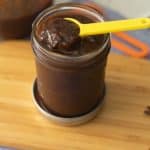Homemade Tamarind Paste
Learn how to make tamarind paste, the quintessential ingredient of the South Indian cuisine in bulk at home from the tamarind block.
Servings: 20 oz (yield, nutrition value is approx)
Calories: 30kcal
Equipment
- Stove-top pressure cooker or electric pressure cooker like Instant Pot
- Strainer - fine mesh or even Instant Pot steamer basket would do
Ingredients
Measurement Details | 1 cup - 240ml
- 250 grams tamarind block
- 2.5 cups water
Instructions
- Break the tamarind block into small chunks. If there are any seeds, discard them.
- Place these tamarind block chunks into the inner pot of the IP and add 2.5 cups of water. Make sure to immerse the tamarind fully in the water. 2.5 cups of water should be sufficient. Add a little more if needed.
- If you are using Instant Pot, close the IP lid and pressure cook the tamarind at high pressure for 25 minutes. When the cooking is complete, release the pressure naturally.
- If you are using a stove-top pressure cooker, close the pressure cooker and put the weight on and cook for 4 to 5 whistles. When the cooking is complete, release the pressure naturally.
- Let the tamarind mix cool completely, and now comes the fun part.
- Mix and mash the cooked tamarind thoroughly. (I used my hands. You can use a potato masher as well) While mixing, if you find any hard membranes, seeds, fibers squeeze out the juice and discard them. This initial sieving makes it easy when we strain it again.
- I used my Instant Pot steamer basket to strain the tamarind. But you use the fine mesh strainer also. Place the strainer/filter on top of a bowl.
- Working in batches, add the cooked tamarind mix in the strainer and strain by pressing it with clean hands. Or you can use the back of a spatula or spoon as well. While pressing, set aside the hard membranes and hard particles. The straining and extracting is the time-consuming part but fun and therapeutic one. Also, depending upon the brand, and how much impurities are present, the straining time might vary.
- If you are using soft tamarind, this process will be much easier.
- Mix the tamarind paste collected in the bowl and store it in an air-tight container. I refrigerate it, usually. Use it as required for curries, rasam, and sambar.
Notes
- As I used hard tamarind block, I went with 25 minutes of cooking time. If you are using the seedless soft one, you can cook for 15 minutes and release the pressure naturally.
- Make sure you add sufficient water, but not too much. Adding too much water will yield a not so thick tamarind paste. Runny tamarind paste is not bad, but you might have to adjust the measurement accordingly.
- Do not discard the strained out tamarind flesh or the tamarind solids. You can use them to wash all your brasswares and bronzewares.
Nutrition
Calories: 30kcal | Carbohydrates: 8g | Protein: 1g | Fat: 1g | Saturated Fat: 1g | Sodium: 5mg | Potassium: 79mg | Fiber: 1g | Sugar: 7g | Vitamin A: 4IU | Vitamin C: 1mg | Calcium: 10mg | Iron: 1mg
